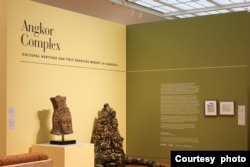Nachiket Chanchani visited Angkor Wat for the first time six years ago. Inspired, the architectural historian began to consider the relationship between the complexities of modern post-genocide Cambodia and the ancient temple complex.
Chanchani, an associate professor of art history at the University of Michigan, has continually reflected on Angkor Wat, juxtaposing the temple complex with the art created since the Khmer Rouge murdered nearly 2 million Cambodians between 1975 and 1979.
During the pandemic, his thoughts have crystallized in the pain, anxiety and fear around the world. “I think this art, whether it’s ancient or recent in Cambodia, can teach us how to maintain stability and find a way forward,” he told VOA’s Khmer service via Zoom.
The University of Michigan Museum of Art (UMMA), one of the largest university museums in the United States, currently displays 80 Cambodian artworks in an exhibition curated by Chanchani in Ann Arbor. The exhibition, titled “Angkor Complex: Cambodia’s Cultural Heritage and Post-Genocide Memory,” opened on February 3 and runs until July 28. Featured artists Vann Nath, Sopheap Pich, Svay Sareth, Amy Lee Sanford and Leang Seckon live in Cambodia and the United States and have works in the exhibition.
The Angkor Archaeological Park is a UNESCO World Heritage Site and covers an area of over 400 square kilometers (155 square miles). Once a city of nearly a million people, the site is home to some of Cambodia’s most famous buildings, including those made famous by their appearances in films such as Lara Croft: Tomb Raider and In the Mood for Love .
Playing with dictionary meanings of “complex,” such as “a whole made up of complex or interrelated parts,” “a building or group of buildings housing related units,” or “a set of repressed desires and memories that exerts a dominant influence over something.” . Personality,” Cianchani sees how the exhibition “makes us think about these different levels, these different kinds of complex ideas. “
Today, “Cambodians view Angkor Wat as a sacred center, a national symbol and a site of memory,” says the exhibition guide.
“Like the bullet-riddled walls of Angkor Wat, contemporary artworks from Cambodia and its diaspora bear the scars of the genocide and related unrest,” Chanchani said, adding that as a non-Cambodian outsider, He was aware of the sensitivity of the exhibition. “This is not something that happened a thousand years ago, you could say, it happened,” he said. “The survivors are still out there.”
Chanchani hopes bringing Cambodian art to the United States will comfort audiences.
But how to move beyond painful memories and the current intertwined global crises described in the exhibition catalog as “public health, economic instability, authoritarian regimes, racial inequality and climate change?”
How does a country recover from an event like the Khmer Rouge, which killed nearly a quarter of its population, to seek to create an agrarian utopia for workers and peasants?
For some Cambodians, 40 years later, when the country is still mentioned in the context of its past sufferings, especially on the international stage, it seems almost impossible to move on or show new faces.
Reaksmey Yean, a writer, curator and researcher on Cambodian art in Phnom Penh, applauded the Michigan show but added that it was a “cliche” because Angkor Wat and the Khmer Rouge have been overused to identify Cambodia.
“Exhibitions about Cambodia and its history and culture are very rare in the United States, so I think having this exhibition is very important to put Cambodia on the map,” Rixme Yan told VOA’s Khmer Service. “However, It’s a cliché to me because it’s been over 20 years since our civil war was completely over and our culture has a lot to show for it.”
Museum director Christina Olson said visitors would have the opportunity to learn about a “unique culture and politics” [significance] Cambodia” through historical and contemporary art by Cambodian and overseas artists.
“At the same time, the exhibition invites reflection on today’s broader cultural, social and political events and fosters dialogue about the lessons that can be learned from the pain and resilience of the Cambodian people,” she added in the release.
Svay Sareth is a Cambodian artist whose sculptures, installations and ongoing performance works, according to Singapore’s Richard Koh Gallery, “are made using materials and processes deliberately associated with war – metal, uniforms, camouflage and the need for Acts of Endurance”. Sareth’s interest in how Cambodia was affected by the war and how the country’s people lived influenced his art.
“I hope audiences in the U.S. [to] Look at how the aftermath of the genocide in Cambodia affected generations,” Sareth said.
Another work by American Khmer artist Amy Lee Sanford, Full Circle, consists of 40 broken clay pots that were repaired and installed in a circle.Known for her “Break Pot” performance work, she will Drop the clay pot from a height and glue all the pieces back togetherstrives to show how a situation can change in a matter of seconds and, even after repair, will never be the same again.
Sanford said she hopes the Michigan exhibit will show that Cambodians “have memories of some important architectural and religious structures … and that contemporary artists are doing things now that are relevant to history but also relevant to looking toward the future.”
Follow us on Google news ,Twitter , and Join Whatsapp Group of thelocalreport.in

![Kristina Olson, director of the University of Michigan Art Museum, said viewers will have the opportunity to learn about "unique culture and politics [significance] Cambodia" Exhibition deadline is July 28, 2024. (Photo courtesy of UMMA)](https://gdb.voanews.com/01000000-c0a8-0242-d05e-08dc404ce4a3_w250_r0_s.jpg)